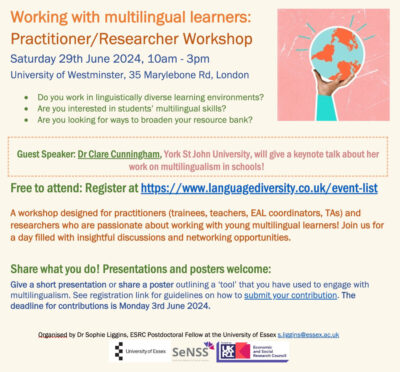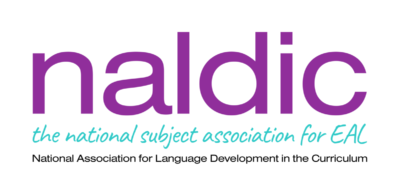 Teacher and researcher Dr Sophie Liggins shares with the NALDIC community some resources and activities for working multilingually
Teacher and researcher Dr Sophie Liggins shares with the NALDIC community some resources and activities for working multilingually
During a lesson with new to English students, a group of Pashto-speaking girls worked together to explain how to make Mantu, the popular Afghan dish. The classroom was filled with a lively exchange of home recipes and a healthy amount of discussion about how to roll out the dough and which filling was tastiest! But this collective construction of recipes in English was only possible thanks to a simultaneous discussion in the home language of the students.
This is a prime example of how important encouraging plurilingualism is to learning development as well as the enrichment of self-concept and social cohesion (García and Li Wei 2014, Creese and Blackledge 2010). As classroom practitioners who work with multilingual students, we generally have ways to use home languages as part of our resource bank- using a bilingual dictionary, asking students how something is said in a home language, and pairing talk partners according to their common languages. We make bilingual key word glossaries, we put up signs in multiple languages, we translate documents so that they are accessible to parents… the list of everyday translanguaging is long!
However, when it comes to the availability of concrete resources, schemes of work, or even curricula designed for educating multilingually, examples do not seem so commonplace. So where do we source them?
Some well-known examples include the wonderful ROMTELs project that involved parents from Roma communities in the retelling of local histories in the primary classroom, and the fantastic World of Languages and Languages of the World project which encourages deeper thinking about language, involving the languages students speak.
In her recent NALDIC blog, EAL coordinator Anna Czebiolko sums up the power of translanguaging sharing some co-curricular activities and Jacob Huckle provided some useful guidance on routines for translanguaging in the classroom.
The online platform Creative Multilingualism also has a great list of activities and exercises to use for harnessing multilingualism in the classroom. It is possible to find an activity book based on using real life experiences to teach Maths, for example, yet advice for using home languages to teach literacy is currently restricted to academic writing or teacher guides at best.
Of course, given the flexible and dynamic nature of multilingualism in school settings, a concrete translanguaging curriculum is not what I think we should be seeking. However, we must consider the current status quo in which EAL does not have subject-specific status. There is no statutory guidance or content provision for practitioners in this area of curriculum (Leung, 2016) and the lack of official policy on how linguistic repertoires should be drawn upon means that the more widely available resources for doing so, the better.
As part of a research project to explore young multilingual students’ responses to a multilingual pedagogical approach (Liggins, 2023), I used a 15-week activity set (a selection available to download here), which I designed with a linguistically diverse classroom in mind, not only considering a wide range of languages but also a wide range of competencies in those languages.

The foci of activities range from multilingual awareness (exploring stories of multilingual characters, language portraits), positioning the bilingual student as an expert linguist (translation challenges, picture dictionary creation) raising the status of minority languages in the school environment (mural of an imaginary street, influenced by local landmarks which represent languages spoken) and the production of creative texts in which students use two or more languages fluidly for enhanced expression (poetry).
I used this as material for an after-school club but there are many parts of the resource that can be used within other settings, such as starters in ML or English lessons, language awareness in tutor times or during interventions with students who are new to English. Whilst these examples certainly work towards wider availability of structured guidance, having a space in which these resources are collated, reviewed and publicised would be a helpful step towards stronger educational efforts to develop children’s plurilingual abilities.
On June 29th 2024, I will be holding a workshop for practitioners and researchers passionate about working with young multilingual learners. The aim for the day is to bring together tools for working with multilingual students which will be followed by the creation of an online hub for sharing resources. We have a wonderful guest speaker, Clare Cunningham from York St John University, who will talk to us about her work on multilingualism in schools. Participant presentations are welcome, so please click here to join or pass on to friends and colleagues!

References
Creese, A. and Blackledge, A. (2010) Translanguaging in the Bilingual Classroom: A Pedagogy for Learning and Teaching? The Modern Language Journal, Vol. 94, No. 1 (Spring, 2010), pp. 103-115. Wiley
García, O . & Li Wei (2014) Translanguaging: Language, Bilingualism and Education Palgrave Macmillan. Hampshire THE LINGUISTIC MINORITIES PROJECT. (1983). Early Years, 3(2), 7. https://doi.org/10.1080/0957514830030204
Leung, C. (2016) English as an additional language – a genealogy of language-in-education policies and reflections on research trajectories, Language and Education, 30:2, 158-174, DOI: 10.1080/09500782.2015.1103260
Liggins, S.(2023) Heritage language speakers’ responses to plurilingual pedagogies in a secondary school context in: Pahl, K., Ainsworth, S., McCrory, G. and Griffiths, D., (eds.) Multilingualism and Multimodality: Working at the Intersection. Multilingual Matters (Channel View Publications), Bristol.

Do you have a story to share?
- Join one of our Regional or Special Interest Groups
- Attend one of our free NALDIC events this year
- Write a post for the NALDIC blog –get in touch



